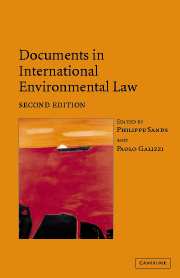Book contents
- Frontmatter
- Contents
- Preface
- PART I General instruments
- PART II Atmosphere
- 5 Convention on Long-Range Transboundary Air Pollution, 13 November 1979
- 5A Protocol to the 1979 Convention on Long-Range Transboundary Air Pollution on Further Reduction of Sulphur Emissions, 14 June 1994
- 5B Non-Compliance Procedure
- 6 Convention for the Protection of the Ozone Layer, 22 March 1985
- 6A Montreal Protocol on Substances that Deplete the Ozone Layer, 16 September 1987
- 6B Non-Compliance Procedure
- 7 United Nations Framework Convention on Climate Change, 9 May 1992
- 7A Kyoto Protocol to the United Nations Framework Convention on Climate Change, 11 December 1997
- 7B Marrakech Accords (extracts)
- PART III Oceans: global
- PART IIIB Oceans: regional
- PART IV Freshwater resources
- PART V Biodiversity
- PART VIA Hazardous substances and activities: nuclear
- PART VIB Hazardous substances and activities: pesticides
- PART VIC Hazardous substances and activities: waste
- PART VII Human rights and the environment
- PART VIII War and the environment
- PART IX Trade and the environment
- PART X Environmental impact assessment and access to information
- PART XI Liability for environmental damage and breaches of environmental obligations
- PART XII The Antarctic
7A - Kyoto Protocol to the United Nations Framework Convention on Climate Change, 11 December 1997
Published online by Cambridge University Press: 05 June 2012
- Frontmatter
- Contents
- Preface
- PART I General instruments
- PART II Atmosphere
- 5 Convention on Long-Range Transboundary Air Pollution, 13 November 1979
- 5A Protocol to the 1979 Convention on Long-Range Transboundary Air Pollution on Further Reduction of Sulphur Emissions, 14 June 1994
- 5B Non-Compliance Procedure
- 6 Convention for the Protection of the Ozone Layer, 22 March 1985
- 6A Montreal Protocol on Substances that Deplete the Ozone Layer, 16 September 1987
- 6B Non-Compliance Procedure
- 7 United Nations Framework Convention on Climate Change, 9 May 1992
- 7A Kyoto Protocol to the United Nations Framework Convention on Climate Change, 11 December 1997
- 7B Marrakech Accords (extracts)
- PART III Oceans: global
- PART IIIB Oceans: regional
- PART IV Freshwater resources
- PART V Biodiversity
- PART VIA Hazardous substances and activities: nuclear
- PART VIB Hazardous substances and activities: pesticides
- PART VIC Hazardous substances and activities: waste
- PART VII Human rights and the environment
- PART VIII War and the environment
- PART IX Trade and the environment
- PART X Environmental impact assessment and access to information
- PART XI Liability for environmental damage and breaches of environmental obligations
- PART XII The Antarctic
Summary
Editorial note
The Kyoto Protocol to the Framework Convention on Climate Change was adopted by the third conference of the parties in December 1997. Negotiations for a protocol to the Convention commenced in 1995 after the first conference of the parties, meeting in Berlin, determined that the commitments provided for in Article 4(2)(a) and (b) of the Conventionwere ‘not adequate’ and decided to launch a process to strengthen the commitments of Annex I parties through the adoption of a protocol or another legal instrument. Negotiations were to be conducted as a matter of urgency with a view to adopting the results at the Third conference of the parties in 1997. The Kyoto Protocol was adopted at the Third conference of the parties and opened for signature on 16 March 1998. The Kyoto Protocol commits Annex I parties to quantified emissions reductions and a timetable for their achievement. The basic obligation accepted by the Annex I parties is set out in Article 3(1). It provides that Annex I parties ‘shall, individually or jointly, ensure that their aggregate anthropogenic carbon dioxide equivalent emissions of the greenhouse gases listed in Annex A do not exceed their assigned amounts’. The ‘assigned amounts’ are calculated pursuant to each party's quantified emission limitation and reduction commitment inscribed in Annex B. Annex I parties must implement their obligation under Article 3(1) ‘with a view to reducing their overall emissions of [Annex A] gases by at least 5 per cent below 1990 levels in the commitment period 2008 to 2012’.
- Type
- Chapter
- Information
- Documents in International Environmental Law , pp. 153 - 178Publisher: Cambridge University PressPrint publication year: 2004
- 20
- Cited by



